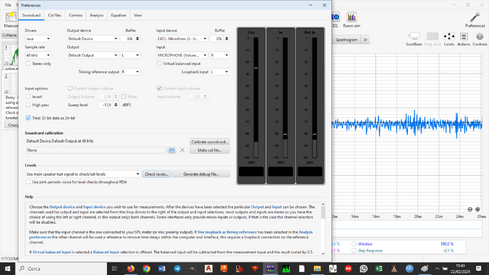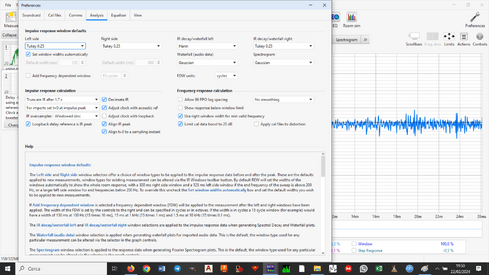Hi to all.
I need your help to make a proper measurments of acoustic phase.
Currently my 3-way system allows me to move all the speakers back and forth individually, but what interests me now is to be able to measure and evaluate the acoustic phase between mid and tweeter. I work like this:
- Dayton UMM6 USB microphone
- microphone at medium height between mid and tw (approximately 1 m), at a distance of 1 m.
- measurement with active "use acoustic timing reference"
- I only measure the mid (the beep you hear at the start of the swipe is obviously at a low level, but still recognized by the microphone and rew)
- I access the "impulse" window and see the first peak after the ref peak after about 3-3.5 ms
- in the window management panel I set "right windows" to the value just before the peak of the first reflection, therefore 3-3.5 ms and apply, thus obtaining the windowed measurement and the acoustic phase.
- I detach the mid and attach the tw, repeat the measurements as above, obtaining the data of only the tw. I go into the impulse, establish the windowing time and apply, I find the tw phase.
- in this way I believe (I thought) I had found the acoustic phases of the 2 individual drivers, and by moving the tw back mm by mm find the position of the best phase condition between the 2 drivers.
- Instead, if I repeat the measurement of the tweeter several times (without moving anything, but only by repeating the measurement), I never get the same result, but the phase also varies by 80-120°
What am I doing wrong? what's wrong? can you please help me? I can't sleep at night on this anymore....
Thank you all!
I need your help to make a proper measurments of acoustic phase.
Currently my 3-way system allows me to move all the speakers back and forth individually, but what interests me now is to be able to measure and evaluate the acoustic phase between mid and tweeter. I work like this:
- Dayton UMM6 USB microphone
- microphone at medium height between mid and tw (approximately 1 m), at a distance of 1 m.
- measurement with active "use acoustic timing reference"
- I only measure the mid (the beep you hear at the start of the swipe is obviously at a low level, but still recognized by the microphone and rew)
- I access the "impulse" window and see the first peak after the ref peak after about 3-3.5 ms
- in the window management panel I set "right windows" to the value just before the peak of the first reflection, therefore 3-3.5 ms and apply, thus obtaining the windowed measurement and the acoustic phase.
- I detach the mid and attach the tw, repeat the measurements as above, obtaining the data of only the tw. I go into the impulse, establish the windowing time and apply, I find the tw phase.
- in this way I believe (I thought) I had found the acoustic phases of the 2 individual drivers, and by moving the tw back mm by mm find the position of the best phase condition between the 2 drivers.
- Instead, if I repeat the measurement of the tweeter several times (without moving anything, but only by repeating the measurement), I never get the same result, but the phase also varies by 80-120°
What am I doing wrong? what's wrong? can you please help me? I can't sleep at night on this anymore....
Thank you all!

















